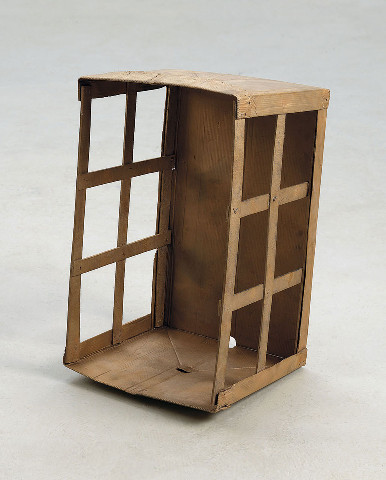Rachel Whiteread
28 Jan - 22 Mar 2014
RACHEL WHITEREAD
28 January – 22 March 2014
The reason my work has affected people over the years is because it draws people's attention to their lives and the things in their lives. There's a certain amount of humility that goes with that.
—Rachel Whiteread
Gagosian Geneva is pleased to present an exhibition of recent sculpture and works on paper by Rachel Whiteread.
Whiteread’s approach to sculpture is predicated on the translation of negative space into solid form. Casting from everyday objects, or from spaces around or within furniture and architecture, she uses materials such as rubber, dental plaster and resin to record every nuance. In recent large-scale works, the empty interiors of wooden garden sheds were rendered in concrete and steel, recalling the earlier architectural works Ghost (1990), House (1993), and the imposing concrete sculpture Boathouse (2010), installed on the water’s edge in the remote Nordic landscape of Røykenviken.
This exhibition focuses on a series of recent sculptures cast in resin from doors and windows in ethereal shades of eau-de-nil or steely gray, and a selection of layered collages incorporating cardboard, celluloid and silver leaf. In the surfaces of the sculptural works, the effects of changing light and shadow become subjective dimensions. Propped against or affixed to walls, these massive yet spectral counterparts to the utilitarian elements from which they derive echo earlier large-scale resin works such as Untitled (Floor) (1994) and One Hundred Spaces (1995).
Whiteread’s works on paper reveal aesthetic nuances that move beyond the found histories of her sculptural work. Untitled (Amber) and Untitled (Green) (both 2012) are diminutive cardboard constructions mounted on graphite-marked notepaper, painted with silver leaf to form tiny, imperfect monuments complete with celluloid “windows.” Each work freshly engages her ongoing concerns with mass and void, the textures of life and history, and ubiquitous traces of human presence.
Rachel Whiteread was born in London in 1963. She studied painting at Brighton Polytechnic from 1982–85 and sculpture at the Slade School of Fine Art from 1985–87. She won the Turner Prize in 1993. Her work has been exhibited internationally in many solo and group exhibitions, including the British Pavilion at the 47th Venice Biennale (1997); “Rachel Whiteread,” Serpentine Gallery, London (2001, traveled to Scottish National Gallery of Modern Art, Edinburgh); “Transient Spaces,” Deutsche Guggenheim, Berlin (2001, traveled to the Solomon R. Guggenheim Museum, New York, through 2002); Kunsthaus Bregenz, Austria (2005); MADRE, Naples (2007); Museum of Fine Arts, Boston (2009); and “Rachel Whiteread: Drawings,” Hammer Museum, Los Angeles (2010, traveled to Nasher Sculpture Center, Dallas and Tate Britain, London). Notable public commissions include House (1993), Water Tower (New York, 1998), Monument (London, 2001), and Embankment at Tate Modern Turbine Hall, London (2005). In 1996 she received the controversial commission for the Holocaust Memorial at the Judenplatz in Vienna, which she completed in 2000.
Whiteread lives and works in London.
28 January – 22 March 2014
The reason my work has affected people over the years is because it draws people's attention to their lives and the things in their lives. There's a certain amount of humility that goes with that.
—Rachel Whiteread
Gagosian Geneva is pleased to present an exhibition of recent sculpture and works on paper by Rachel Whiteread.
Whiteread’s approach to sculpture is predicated on the translation of negative space into solid form. Casting from everyday objects, or from spaces around or within furniture and architecture, she uses materials such as rubber, dental plaster and resin to record every nuance. In recent large-scale works, the empty interiors of wooden garden sheds were rendered in concrete and steel, recalling the earlier architectural works Ghost (1990), House (1993), and the imposing concrete sculpture Boathouse (2010), installed on the water’s edge in the remote Nordic landscape of Røykenviken.
This exhibition focuses on a series of recent sculptures cast in resin from doors and windows in ethereal shades of eau-de-nil or steely gray, and a selection of layered collages incorporating cardboard, celluloid and silver leaf. In the surfaces of the sculptural works, the effects of changing light and shadow become subjective dimensions. Propped against or affixed to walls, these massive yet spectral counterparts to the utilitarian elements from which they derive echo earlier large-scale resin works such as Untitled (Floor) (1994) and One Hundred Spaces (1995).
Whiteread’s works on paper reveal aesthetic nuances that move beyond the found histories of her sculptural work. Untitled (Amber) and Untitled (Green) (both 2012) are diminutive cardboard constructions mounted on graphite-marked notepaper, painted with silver leaf to form tiny, imperfect monuments complete with celluloid “windows.” Each work freshly engages her ongoing concerns with mass and void, the textures of life and history, and ubiquitous traces of human presence.
Rachel Whiteread was born in London in 1963. She studied painting at Brighton Polytechnic from 1982–85 and sculpture at the Slade School of Fine Art from 1985–87. She won the Turner Prize in 1993. Her work has been exhibited internationally in many solo and group exhibitions, including the British Pavilion at the 47th Venice Biennale (1997); “Rachel Whiteread,” Serpentine Gallery, London (2001, traveled to Scottish National Gallery of Modern Art, Edinburgh); “Transient Spaces,” Deutsche Guggenheim, Berlin (2001, traveled to the Solomon R. Guggenheim Museum, New York, through 2002); Kunsthaus Bregenz, Austria (2005); MADRE, Naples (2007); Museum of Fine Arts, Boston (2009); and “Rachel Whiteread: Drawings,” Hammer Museum, Los Angeles (2010, traveled to Nasher Sculpture Center, Dallas and Tate Britain, London). Notable public commissions include House (1993), Water Tower (New York, 1998), Monument (London, 2001), and Embankment at Tate Modern Turbine Hall, London (2005). In 1996 she received the controversial commission for the Holocaust Memorial at the Judenplatz in Vienna, which she completed in 2000.
Whiteread lives and works in London.

